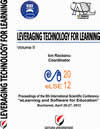ELEARNING SYSTEM IMPLEMENTATION STRATEGY TO SUPPORT THE INDIVIDUAL CONSUMER
ELEARNING SYSTEM IMPLEMENTATION STRATEGY TO SUPPORT THE INDIVIDUAL CONSUMER
Author(s): Constanţa Enea, Amelia Boncea, Carina-Elena StegăroiuSubject(s): Education
Published by: Carol I National Defence University Publishing House
Keywords: elearning; managenent; virtual library; self-training
Summary/Abstract: E-learning is the technology that has revolutionized the traditional distance learning, and opportunities have been seized and used both in schools and at public or private organizations. In terms of structure, an eLearning system provides facilities for the transfer of knowledge by developing and publishing educational content in the form of courses or virtual libraries and knowledge verification and testing using simulated management scenarios or case studies for evaluation. Taking into account its main features, we define the concept of eLearning system. An eLearning system consists of a set of methods, techniques, tools and procedures that ensure the provision of learning or training programs, using electronic means, as well as evaluating the assimilation of knowledge by students. Training of beneficiaries through an integrated eLearning can be done in three ways: self-training (student-computer interaction) personal education (student-lecturer interaction) and virtual classroom (interaction between several students and a tutor). The main instrument of self-training is virtual bibliotheca whose definition is shown below. A virtual library is a collection of articles and publications in electronic format that can be called using Internet technologies by a group of users, based on a set of bibliographic references, accessible online. Virtual Library is an information and training to its employees and other categories of stakeholders, providing them information and organizational knowledge, based on access rights. Also, the virtual library of an organization can be used in the process of training or professional self-improvement because it provides documentation for extending and deepening students' knowledge transmitted via eLearning. In addition to its general features, eLearning system must satisfy a number of specific requirements set out in the nature of the market and address any specific, investments in workforce training and retraining needs are among the emerging economies. This paper proposes a strategy for implementing the eLearning system, seen as a component of development strategy of the organization.
Journal: Conference proceedings of »eLearning and Software for Education« (eLSE)
- Issue Year: 8/2012
- Issue No: 02
- Page Range: 536-540
- Page Count: 5
- Language: English

